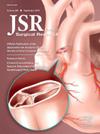Tourniquet in Place as Full Trauma Team Activation Criterion Maintains an Acceptable Overtriage Rate
IF 1.8
3区 医学
Q2 SURGERY
引用次数: 0
Abstract
Introduction
Prehospital tourniquet placement is not a required criterion for standard trauma team activation (TTA-S) as recommended by the American College of Surgeons Committee on Trauma. Educational campaigns such as STOP THE BLEED have led to an increase in tourniquet applications in the prehospital setting. We intend to evaluate if using extended trauma team activation (TTA-T) criteria, which includes tourniquet application, would lead to an acceptable amount of overtriage.
Methods
This was a multicenter retrospective analysis, utilizing the American Association for the Surgery of Trauma Major Extremity Trauma Tourniquet Database, comparing the overtriage rate of TTA-S criteria against the TTA-T criteria.
Results
A total of 1235 patients were included, with 687 meeting the TTA-S criteria and an additional 175 patients meeting the TTA-T criteria. The overtriage rate was calculated to be 21.2%, within the accepted over triage rate of 25%-35%.
Conclusions
Field tourniquet application for life-threatening hemorrhage, although not an American College of Surgeons Committee on Trauma criterion for TTA, should be considered for full TTA. Utilizing this as a criterion for TTA is associated with an acceptable rate of overtriage, while also having the benefit of rapid surgical team evaluation and intervention for possible life- or limb-threatening injuries.
作为全面创伤小组激活标准,止血带在适当位置保持可接受的过度分类率
院前止血带的放置并不是美国外科医师学会创伤委员会推荐的标准创伤小组激活(TTA-S)的必要标准。诸如“止血”等教育运动已导致院前环境中止血带应用的增加。我们打算评估使用扩展创伤小组激活(TTA-T)标准,包括止血带的应用,是否会导致可接受的过度分类。方法采用多中心回顾性分析,利用美国创伤外科协会四肢创伤止血带数据库,比较ta - s标准与ta - t标准的过度分诊率。结果共纳入1235例患者,其中687例符合ta - s标准,另有175例符合ta - t标准。超额分诊率计算为21.2%,在可接受的25%-35%的超额分诊率范围内。结论现场止血带应用于危及生命的出血,虽然没有美国外科学会创伤委员会的TTA标准,但应考虑全面的TTA。将此作为TTA的标准与可接受的过度分类率相关,同时也有利于快速外科团队评估和干预可能危及生命或肢体的损伤。
本文章由计算机程序翻译,如有差异,请以英文原文为准。
求助全文
约1分钟内获得全文
求助全文
来源期刊
CiteScore
3.90
自引率
4.50%
发文量
627
审稿时长
138 days
期刊介绍:
The Journal of Surgical Research: Clinical and Laboratory Investigation publishes original articles concerned with clinical and laboratory investigations relevant to surgical practice and teaching. The journal emphasizes reports of clinical investigations or fundamental research bearing directly on surgical management that will be of general interest to a broad range of surgeons and surgical researchers. The articles presented need not have been the products of surgeons or of surgical laboratories.
The Journal of Surgical Research also features review articles and special articles relating to educational, research, or social issues of interest to the academic surgical community.

 求助内容:
求助内容: 应助结果提醒方式:
应助结果提醒方式:


